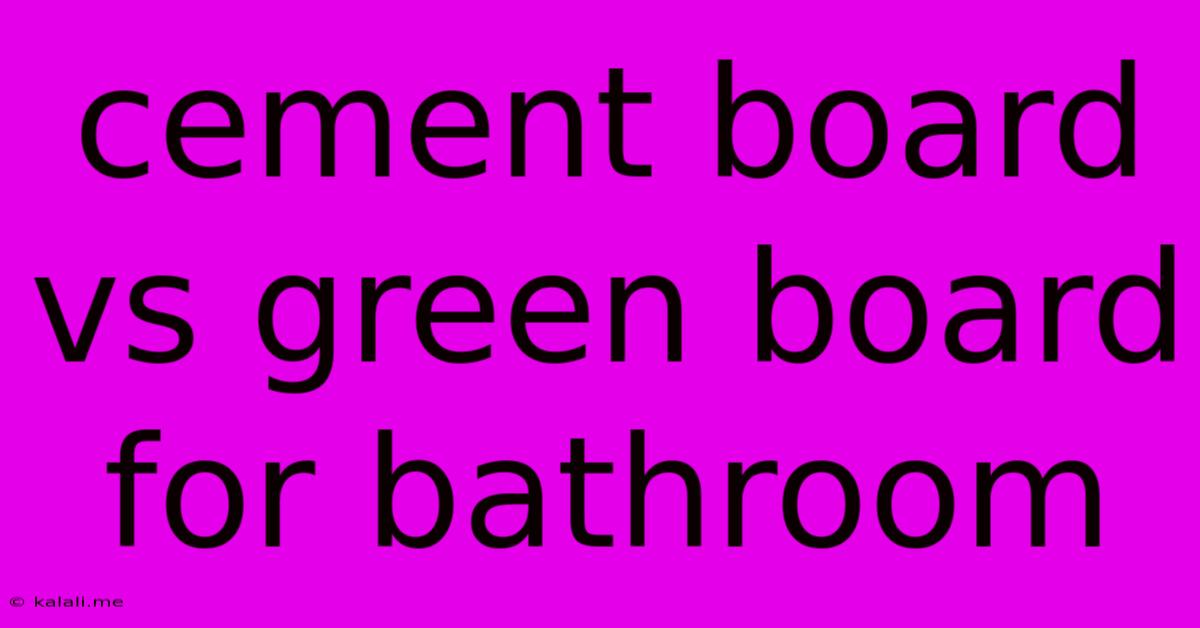Cement Board Vs Green Board For Bathroom
Kalali
May 24, 2025 · 3 min read

Table of Contents
Cement Board vs. Green Board for Bathroom: Which is the Best Choice?
Choosing the right backer board for your bathroom renovation is crucial for a long-lasting, water-resistant finish. This article will compare cement board and green board (also known as drywall or gypsum board), highlighting their strengths and weaknesses to help you make an informed decision. Whether you're tiling a shower, installing a backsplash, or simply seeking a moisture-resistant wall covering, understanding the differences between these materials is key to a successful project.
Understanding the Differences: Cement Board vs. Green Board
Both cement board and green board are commonly used as backer boards in bathrooms, but they differ significantly in their composition and properties. Cement board, as the name suggests, is a composite material made from Portland cement, sand, and cellulose fibers. This creates a dense, hard, and highly water-resistant surface. Green board, on the other hand, is a type of gypsum board treated with a moisture-resistant coating. While it offers better moisture resistance than standard drywall, it's not as impervious to water as cement board.
Key Features and Considerations
Here's a breakdown of the key features of each material, helping you weigh their pros and cons for your bathroom project:
Cement Board: The Heavyweight Champion
- Superior Water Resistance: Cement board's primary advantage is its exceptional water resistance. It's far less likely to absorb moisture, making it ideal for shower enclosures and areas exposed to high humidity.
- Durability and Strength: Its dense composition makes it incredibly strong and durable, capable of withstanding impacts and preventing cracks.
- More Difficult to Work With: Cement board is heavier and more challenging to cut and install than green board. It requires specialized tools and more experience.
- Higher Cost: Cement board typically comes with a higher price tag compared to green board.
Green Board: The Budget-Friendly Option
- Cost-Effective: Green board is a more affordable option, making it attractive for budget-conscious projects.
- Easier to Install: It's lighter and easier to cut and install, making it a preferred choice for DIY enthusiasts.
- Less Durable: While treated for moisture resistance, it's not as water-resistant as cement board and is more prone to damage from water penetration over time.
- Not Ideal for High-Moisture Areas: Green board is generally not recommended for direct shower applications or areas with prolonged exposure to water.
Choosing the Right Material for Your Bathroom Project
The best choice ultimately depends on your specific needs and the location of the installation:
-
Shower Enclosures and Wet Areas: Cement board is the clear winner. Its superior water resistance is crucial in preventing water damage and mold growth.
-
Backsplashes and Walls: Green board is a suitable option, provided it's properly sealed and protected from direct water contact. However, cement board offers better long-term protection.
-
Budget Constraints: If budget is a major concern, green board can be a viable alternative for areas less prone to water exposure. However, consider the potential long-term costs of repairs if water damage occurs.
-
DIY vs. Professional Installation: If you're a DIY enthusiast, green board might be easier to handle. However, professional installation is recommended for both materials, especially for complex projects involving showers.
Beyond the Basics: Additional Factors
Remember to consider these additional factors when making your decision:
- Proper waterproofing: Regardless of your choice, proper waterproofing behind the backer board is essential for preventing water damage. Use a high-quality waterproofing membrane before installing the backer board.
- Tile type: The weight and size of your tiles will influence the strength required from your backer board. Larger, heavier tiles might benefit from the extra strength of cement board.
- Ventilation: Good ventilation in your bathroom is crucial for preventing moisture buildup, regardless of the backer board material you choose.
By carefully considering these factors, you can select the optimal backer board for your bathroom renovation project, ensuring a durable and water-resistant finish that will last for years to come. Remember, investing in the right material is a crucial step in protecting your home from potential water damage.
Latest Posts
Latest Posts
-
How To Attach 2 X 4 To I Beams
May 24, 2025
-
How To Save A Youtube Video To Google Drive
May 24, 2025
-
Square Butt Or Bevel Cut Butt Joints On Deck Boards
May 24, 2025
-
Class 2 Transoformer Adapter How To Measure Pin Size
May 24, 2025
-
How To Hang Swing From Ceiling
May 24, 2025
Related Post
Thank you for visiting our website which covers about Cement Board Vs Green Board For Bathroom . We hope the information provided has been useful to you. Feel free to contact us if you have any questions or need further assistance. See you next time and don't miss to bookmark.